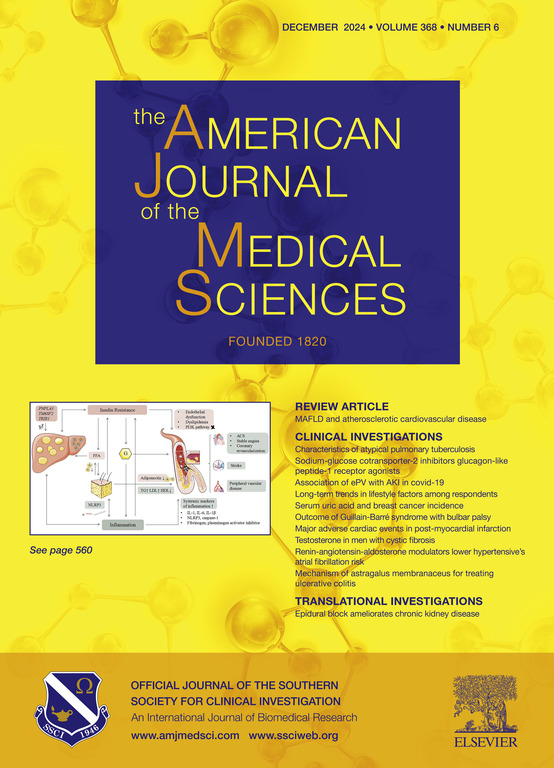Double-filtration plasmapheresis versus therapeutic plasma exchange in the treatment of anti-glomerular basement membrane nephritis: A cohort study
IF 1.8
4区 医学
Q2 MEDICINE, GENERAL & INTERNAL
引用次数: 0
Abstract
Background
Therapeutic plasma exchange (TPE) is acknowledged as the standard therapy for anti-glomerular basement membrane (GBM) nephritis. In recent years, double-filtration plasmapheresis (DFPP) has been proposed as an equally effective plasmapheresis modality. The present study aimed to compare the efficacy and safety of TPE and DFPP for the treatment of anti-GBM nephritis.
Methods
We conducted a retrospective cohort study of anti-GBM patients who received plasmapheresis from February 2011 to October 2023 at West China Hospital of Sichuan University. The primary outcome was a composite endpoint of in-hospital death or dialysis dependency at discharge. The secondary outcomes included length of hospitalization, long-term mortality and end-stage renal disease (ESRD). We also compared anti-GBM antibody titer reduction, plasmapheresis-related adverse events. Logistic regression and Cox hazard proportional regression analyses were performed to investigate potential risk factors of primary outcome and long-term patient/renal survival.
Results
In total, 58 anti-GBM nephritis patients were included in this study. No significant differences were observed in the incidence of primary outcome between patients receiving DFPP and TPE in fully adjusted logistic regression model (OR=0.23, 95 % CI=0.04–1.37, P = 0.106). In surviving patients, the length of hospitalization was similar (21 vs. 23 days, P = 0.165). With a follow-up of 3-years, K‒M survival analysis revealed similar risk of death or ESRD between the 2 groups (P = 0.424; P = 0.987). According to fully adjusted Cox regression analyses, anti-GBM nephritis patients receiving DFPP achieved comparable patient (HR=1.18, 95 % CI=0.23–6.04; P = 0.845) and kidney survival (HR=0.96, 95 % CI=0.13–6.86; P = 0.967) to those receiving TPE. After plasmapheresis treatment, the anti-GBM antibody concentration significantly decreased in both groups (DFPP: 136.47 vs 27.20 AU/mL, P < 0.001; TPE: 122.09 vs 27.40 AU/mL, P = 0.016), with fewer allergy episodes observed in the DFPP group (13.64 % vs 42.86 %, P = 0.049). Besides, older age and concomitant infection were independently related to 3-year patient mortality (P < 0.001, P = 0.031), whereas high-dose methylprednisolone treatment seemed to be associated with a lower risk of ESRD (P = 0.034).
Conclusions
Anti-GBM nephritis patients who received DFPP achieved comparable short- and long-term prognosis to those who received TPE. With less plasma consumption, DFPP was also associated with fewer allergy episodes. DFPP might be an alternative modality of plasmapheresis for anti-GBM nephritis, especially in the setting of limited blood resources.
双滤过血浆置换与治疗性血浆置换治疗抗肾小球基底膜肾炎:队列研究。
背景:治疗性血浆置换(TPE)被认为是抗肾小球基底膜肾炎(GBM)的标准治疗方法。近年来,双过滤血浆置换(DFPP)被认为是一种同样有效的血浆置换方式。本研究旨在比较TPE和DFPP治疗抗gbm肾炎的疗效和安全性。方法:对2011年2月至2023年10月在四川大学华西医院接受血浆置换的抗gbm患者进行回顾性队列研究。主要终点是院内死亡或出院时透析依赖的复合终点。次要结局包括住院时间、长期死亡率和终末期肾病(ESRD)。我们还比较了抗gbm抗体滴度降低、血浆分离相关的不良事件。采用Logistic回归和Cox风险比例回归分析来调查主要结局和患者/肾脏长期生存的潜在危险因素。结果:共纳入58例抗gbm肾炎患者。在完全调整logistic回归模型中,接受DFPP和TPE的患者的主要结局发生率无显著差异(OR=0.23, 95% CI=0.04-1.37, P=0.106)。存活患者的住院时间相似(21天vs. 23天,P=0.165)。随访3年,K-M生存分析显示两组患者的死亡或ESRD风险相似(P=0.424;P = 0.987)。根据全校正Cox回归分析,接受DFPP治疗的抗gbm肾炎患者达到可比患者(HR=1.18, 95% CI=0.23-6.04;P=0.845)和肾脏存活率(HR=0.96, 95% CI=0.13-6.86;P=0.967)。血浆置换治疗后,两组抗gbm抗体浓度均显著降低(DFPP: 136.47 vs 27.20 AU/mL, p)。结论:接受DFPP治疗的抗gbm肾炎患者与接受TPE治疗的患者短期和长期预后相当。由于血浆消耗较少,DFPP也与较少的过敏发作有关。dppp可能是抗gbm肾炎血浆置换的一种替代方式,特别是在血液资源有限的情况下。
本文章由计算机程序翻译,如有差异,请以英文原文为准。
求助全文
约1分钟内获得全文
求助全文
来源期刊
CiteScore
4.40
自引率
0.00%
发文量
303
审稿时长
1.5 months
期刊介绍:
The American Journal of The Medical Sciences (AJMS), founded in 1820, is the 2nd oldest medical journal in the United States. The AJMS is the official journal of the Southern Society for Clinical Investigation (SSCI). The SSCI is dedicated to the advancement of medical research and the exchange of knowledge, information and ideas. Its members are committed to mentoring future generations of medical investigators and promoting careers in academic medicine. The AJMS publishes, on a monthly basis, peer-reviewed articles in the field of internal medicine and its subspecialties, which include:
Original clinical and basic science investigations
Review articles
Online Images in the Medical Sciences
Special Features Include:
Patient-Centered Focused Reviews
History of Medicine
The Science of Medical Education.

 求助内容:
求助内容: 应助结果提醒方式:
应助结果提醒方式:


